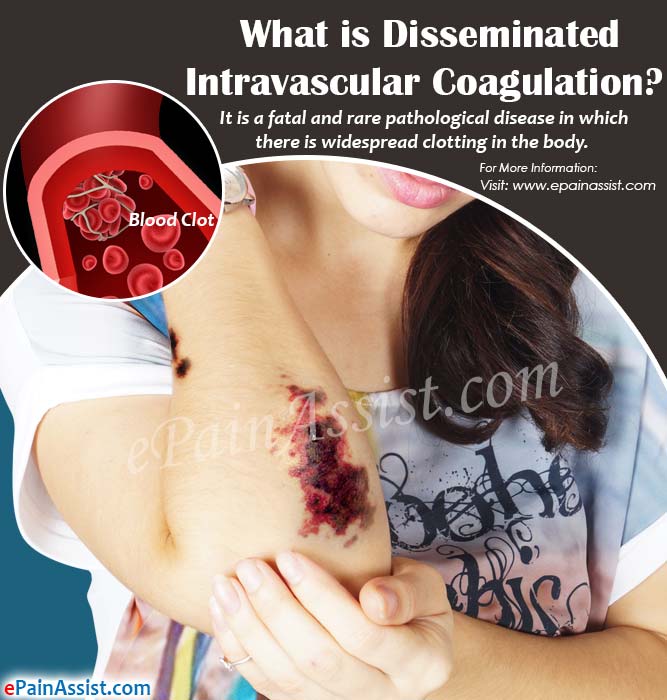What is Disseminated Intravascular Coagulation?
DIC or Disseminated intravascular coagulation is a fatal and rare pathological disease in which there is widespread clotting in the body. This results in the formation of blood clots in the small blood vessels which are present all over the body leading to impaired blood flow to the tissues which can ultimately cause multiple organ damage. Other than this, there is disruption of normal clotting which causes severe bleeding in different areas of the body.
Disseminated intravascular coagulation is a life threatening condition which if ignored can cause death of the patient. If the patient is having bleeding which won’t stop, then it’s imperative to go to an emergency room and seek medical treatment. Disseminated intravascular coagulation is actually a complication of an underlying disorder. In some patients, disseminated intravascular coagulation can be severe; whereas, in some patients it can be insidious and mild. Treatment of Disseminated Intravascular Coagulation aims at treating the underlying condition which is causing DIC.

What are the Causes of Disseminated Intravascular Coagulation?
Over activity of the proteins, which are used in the normal clotting process can lead to disseminated intravascular coagulation. Other causes which contribute to disseminated intravascular coagulation are severe trauma, severe infection or sepsis, surgery, inflammation and tumors/cancer.
Other less common causes of disseminated intravascular coagulation are: hypothermia, large aortic aneurysms, venomous snake bites, burns, pancreatitis, giant hemangiomas, complications during pregnancy and disseminated intravascular coagulation can also develop in patients who have gone into shock.
What are the Risk Factors for Disseminated Intravascular Coagulation?
- Individuals who have undergone surgery are at an increased risk for developing Disseminated Intravascular Coagulation.
- Individuals who have had a blood transfusion are at an increased risk for developing Disseminated Intravascular Coagulation.
- Women who have had an incomplete miscarriage are at an increased risk for developing Disseminated Intravascular Coagulation.
- Women who have delivered a baby are at an increased risk for developing Disseminated Intravascular Coagulation.
- Individuals who have had transfusions are at an increased risk for developing Disseminated Intravascular Coagulation.
- Individuals who have had anesthesia are at an increased risk for developing Disseminated Intravascular Coagulation.
- Individuals who have had certain types of cancer, (especially leukemia) are at an increased risk for developing Disseminated Intravascular Coagulation.
- Individuals who have had sepsis or any bacterial or fungal blood infection are at an increased risk for developing Disseminated Intravascular Coagulation.
- Individuals who have had had liver disease are at an increased risk for developing Disseminated Intravascular Coagulation.
- Individuals who have had serious tissue damage from trauma, head injury, burns etc. are at an increased risk for developing Disseminated Intravascular Coagulation.
What are the Symptoms of Disseminated Intravascular Coagulation?
Bleeding is the main symptom of disseminated intravascular coagulation. Bleeding can also occur from different sites of the body. Bleeding can occur from external areas of the body and from the mucosal tissue (nose and mouth). Internal bleeding can also occur in disseminated intravascular coagulation. Other symptoms of disseminated intravascular coagulation are:
- Decreased blood pressure (hypotension).
- Blood clots.
- Easy bruising.
- Vaginal or rectal bleeding.
- Formation of petechiae, which are the red dots on the skin’s surface.
- In patients who have cancer, disseminated intravascular coagulation is usually insidious and the clotting in the veins occurs more than the excessive bleeding.
How is the Diagnosis of Disseminated Intravascular Coagulation Made?
There are different tests done for the diagnosis of Disseminated Intravascular Coagulation. These tests are related to clotting factors, platelets and other blood components which help in diagnosing Disseminated Intravascular Coagulation. There is no such standard test for diagnosis. Some of the tests which are done if Disseminated Intravascular Coagulation is suspected are:
- Fibrin degradation product.
- Complete blood cell count (CBC) from sample.
- Complete blood cell count (CBC) from smear.
- Partial thromboplastin time.
- Platelet count.
- Serum fibrinogen.
- D-dimer test.
- Prothrombin time.
What are the Complications of DIC?
Complications from Disseminated Intravascular Coagulation can occur from excessive clotting and if it is not treated properly. Disseminated Intravascular Coagulation can have the following complications:
- Formation of blood clots in the small blood vessels which cause oxygen deprivation to organs and limbs.
- Stroke.
- Excessive bleeding can occur which can ultimately cause patient’s death.
What is the Treatment for Disseminated Intravascular Coagulation?
The treatment of Disseminated Intravascular Coagulation depends on its cause. The main aim of treatment of Disseminated Intravascular Coagulation is treating its underlying cause.
Anticoagulants for Treating Disseminated Intravascular Coagulation
For treatment of the clotting problem, patient is given heparin, an anticoagulant, to reduce and prevent clotting. However, patients who have excessive bleeding and who have very low platelets may not be given heparin.
Transfusions for Treating Disseminated Intravascular Coagulation
Patient is given transfusion to replace the platelets which are deficient. The clotting factors which the patient doesn’t have can be replaced with plasma transfusions.
Hospitalization for Treating Disseminated Intravascular Coagulation
Hospitalization, especially in intensive care unit, is needed in patients having acute disseminated intravascular coagulation. Treatment is done to correct the problem which is causing the disseminated intravascular coagulation along with maintaining the function of the organs.
What is the Prognosis of Disseminated Intravascular Coagulation?
The prognosis of DIC or Disseminated Intravascular Coagulation depends on the cause of the development of this condition and the extent of the clotting. If the causative problem can be corrected, then the prognosis is good; however, for most of the patients suffering from Disseminated Intravascular Coagulation, the prognosis is grave.
Disseminated intravascular coagulation occurs as a complication from other medical conditions. The combination of impaired blood flow to the tissues, bleeding and on top of it the underlying causative condition increases the risk of death in the patient. The mortality rate among patients with Disseminated Intravascular Coagulation is about 10 to 50%. The mortality rate is higher in patients who have Disseminated Intravascular Coagulation with sepsis.
